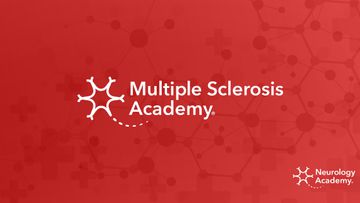Closing lecture: New insights in immunopathogenesis
Event reportsStefan Bittner closed the 8th joint ECTRIMS/ACTRIMS meeting this year, giving up to date evidence on the immunopathogenesis of MS.
He began by outlining the current two-stage model of MS across early stage:
- the migration of T-cells across the blood brain barrier
- reactivation of T-cells y antigen-presenting cells in the perivascular space
- recruitment of further immune cells and lesion development
and the late, or 'diffuse' stage
- likely compartmentalisation of immune response
- new damage pathways with a focus on innate immune system / glial cell-related pathways
- neuron-intrinsic pathways
Stefan proposed a series of questions, wondering whether this two-stage view of MS pathology is too simplistic, whether we need to halt progression, boost beneficial immune system roles, and more.
He highlighted that the past year has seen a plethora of research into many areas which begin to respond to these questions, sharing that there have been 40 high impact papers published in the past 12 months alone.
Stefan provided an overview of the most significant papers over the past year, addressing them across four key topics:
- glial cells
- neurodegeneration
- adaptive immune system
- reverse translation
Glial cells:
- an expanded understanding of inflamed astrocytes
- unravelling the complexity of mononuclear phagocyte composition in neuroinflammation
- new subsets of invading phagocytes
- 8 monocyte and 3 dendritic cells subsets proposed
- monocytes pathological relevant
- diverse roles of CNS myeloid cells
- Microglia capture dead and living invading T-cells
- engulfment of invading microglia protects from CNS inflammation
Key reference:
Wasser B, Luchtman D, Löffel J, et al. CNS-localized myeloid cells capture living invading T cells during neuroinflammation. J Exp Med. 2020;217(6):e20190812. doi:10.1084/jem.20190812
Neurodegeneration and neuroprotection:
- Fresh perspectives on old ideas and new concepts
- Serum neurofilament light (NfL) as an emerging biomarker - NfL correlates with markers of inflammation and can aid early diagnosis
- Neuroinflammation induces toxic protein accumulation in neurons with a rescue by pharmacological proteasome activation
- Brain cortex in not directly affected by inflammation
- neuroinflammation leads to increased cortical neuronal hyperactivity in remission in sites distant from inflammation
- Calcium influx via nanoscale membrane ruptures promotes axonal degeneration in EAE
- And it can be reversed! Independent from T-cell function, IL-4 directly binds IL-4R on neurons, promoting axonal integrity and neuronal recovery in EAE
- Beneficial CNS-immune crosstalk - fast direct neuronal IL-4R signaling pathway
Key references:
- Correale J, Gaitán MI, Ysrraelit MC, Fiol MP. Progressive multiple sclerosis: from pathogenic mechanisms to treatment. Brain. 2017;140(3):527-546. doi:10.1093/brain/aww258
- Ellwardt E, Pramanik G, Luchtman D, et al. Maladaptive cortical hyperactivity upon recovery from experimental autoimmune encephalomyelitis [published correction appears in Nat Neurosci. 2019 Jan;22(1):144]. Nat Neurosci. 2018;21(10):1392-1403. doi:10.1038/s41593-018-0193-2
- Khalil, M., Teunissen, C.E., Otto, M. et al. Neurofilaments as biomarkers in neurological disorders. Nat Rev Neurol 14, 577–589 (2018). https://doi.org/10.1038/s41582-018-0058-z
- Bittner S, Steffen F, Uphaus T, et al. Clinical implications of serum neurofilament in newly diagnosed MS patients: A longitudinal multicentre cohort study. EBioMedicine. 2020;56:102807. doi:10.1016/j.ebiom.2020.102807
New regulators of immune pathways and CNS-specific functions in T-cells:
- TH17 cells in neuroinflammation
- MS and nutrition take their next steps -
- tryptophan, short-chain fatty acid, propionic acid, and more
- T-cells directly target grey matter in PPMS
- T-cells in lesions - beta1-integrin and KV1.2 channel-dependent signalling - stimulates glutamate release from Th17 cells.
- Glutamate release from T-cells could be a therapeutic target
Key references:
- McGinley, A. M. et al. Interleukin-17A serves a priming role in autoimmunity by recruiting IL-1β-producing myeloid cells that promote pathogenic T cells. Immunity https://doi.org/10.1016/j.immuni.2020.01.002 (2020)
- Huang Y, Chen Y, Zhou S, et al. Dual-mechanism based CTLs infiltration enhancement initiated by Nano-sapper potentiates immunotherapy against immune-excluded tumors. Nat Commun. 2020;11(1):622. Published 2020 Jan 30. doi:10.1038/s41467-020-14425-7
- Duscha A, Gisevius B, Hirschberg S, et al. Propionic Acid Shapes the Multiple Sclerosis Disease Course by an Immunomodulatory Mechanism. Cell. 2020;180(6):1067-1080.e16. doi:10.1016/j.cell.2020.02.035
- Birkner K, Wasser B, Ruck T, Thalman C, Luchtman D, Pape, K Schmaul S, Bitar L, Krämer-Albers EM, Stroh A, 'β1-Integrin– and KV1.3 channel–dependent signaling stimulates glutamate release from Th17 cells' J Clin Invest 2020, October 29; 10.1172/JCI126381
Reverse translation: insights into mode of action of approved drugs:
- Low and high affinity T-cells display a different energy metabolism
- New modes of action for dimethyl fumarate
- it reduces Tc17 but not Th17 cells, and shifts transcriptional Tc17 profile towards a CTL-like signature. Tc17 cells before DMF therapy were significantly higher in responders
- DMF inactives the glycolytic GAPDH in mice and humans. it thereby down-regulates aerobic glycolysis in activated myeloid and lymphoid cells, which mediates its anti-inflammatory effects.
Key references:
- L. Klotz, M. Eschborn, M. Lindner, M. Liebmann, M. Herold, C.Janoschka, B. Torres Garrido, A. Schulte-Mecklenbeck, C. C. Gross, J. Breuer, et al, 'Teriflunomide treatment for multiple sclerosis modulates T cell mitochondrial respiration with affinity-dependent effects'. Sci. Transl. Med. 11, eaao5563 (2019).
- Lückel C, Picard F, Raifer H, et al. IL-17+ CD8+ T cell suppression by dimethyl fumarate associates with clinical response in multiple sclerosis. Nat Commun. 2019;10(1):5722. Published 2019 Dec 16. doi:10.1038/s41467-019-13731-z
Related articles
Encouraging excellence, developing leaders, inspiring change
MS Academy was established five years ago and in that time has accomplished a huge amount. The six different levels of specialist MS training are dedicated to case-based learning and practical application of cutting edge research. Home to national programme Raising the Bar and the fantastic workstream content it is producing, this is an exciting Academy to belong to.

